Table of contents
- Letter from the Board
- Modelica Association
- Related projects
- Vendor news
- News from libraries
- Education news
Letter from the Board
Dear Modelica, FMI, SSP, DCP, eFMI interested,
Since a long time, the Modelica Association is more than just Modelica. It is managing a broad set of topics and doing so effectively by distributing the workload among its different Modelica Association Projects. However, there are common problems that require us to join forces across the projects. Hence this autumn we have re-initiated the coordination of our projects with a Modelica Coordination Meeting in Hamburg, Germany. The four most important results of this discussion were:
- Provision of a free FMU import library. The Modelica Language group will then discuss extensions to the Modelica language to enable better means for FMU import across Modelica tools
- Development of free educational material in general to lower entry barrier for Modelica.
- Development of free educational material for the use of SSP in modeling and simulation workflows
- Exploration of APIs for Modelica compilers to enable better integration into coding environments and AI tools or build toolchains.
I want to thank Airbus Operations GmbH for hosting this event and Oliver Lenord (Project Leader of ITEA OpenScaling) for enabling this to be adjunct to the OpenScaling workshop. This meeting was a first step and further coordination is planned: a virtual online meeting is scheduled for January 31 in 2025 and another in-person meeting will be organized in spring 2025, likely to be in Hamburg again. Invitation will be sent out to all Modelica Association members via email.
Update on our conferences
The last quarter of 2024 is all about our conferences in the USA and Asia. The American conference was a very successful event and its proceedings are now available. I want to sincerely thank the very experienced local organization team for all their hard work and also for bringing a wonderful community together. I am also looking forward to participate in the Asian Modelica Conference in South Korea this December.
Furthermore, I am happy to announce the annual ModProd and OpenModelica Workshop in Linköping, taking place at February 3-5.
Last but certainly not least: Preparation for the 16th International Modelica & FMI Conference in beautiful Lucerne, Switzerland are now speeding up. Of highest interest are of course the most important dates:
- April 17, 2025: Deadline for submissions
- June 1, 2025: Deadline for Workshops and Tutorials, and Vendor Presentations
- June 1, 2025: Deadline for Industrial User Presentation submissions
- September 8-10, 2025: 16th International Modelica & FMI Conference
More details are available on the conference website as well as the call for sponsors. The conference will also hold a track for industrial user presentations. This provides an opportunity for industry to report on their successes and challenges without the burden of writing a full academic paper. The Modelica conference series has always been very succesfull in bringing academic research and industrial users together.
Dirk Zimmer on November 11, 2024
Chair of the Modelica Association
This article is provided by Dirk Zimmer (Modelica Association)
Modelica Association
FMI news
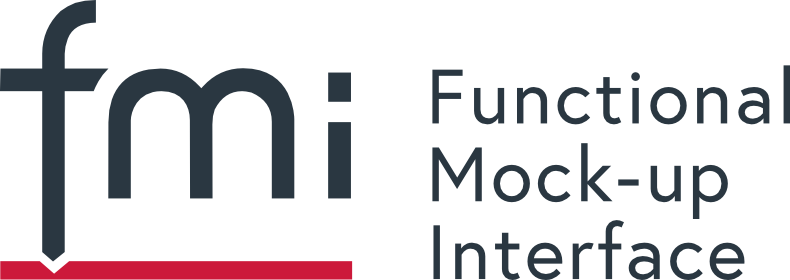
First FMI Advisory Committee Meeting
After the clarification of the FMI Project membership roles, the FMI Project hosted the first FMI Advisory Committee meeting on Nov 5, 2025. We received very valuable feedback, ideas, and feature requests. Thanks to the 70 participants for their contributions and participation! (Participating Companies: Akkodis, Ansys, AVL, Beckhoff, Boeing, Bosch, Claytex, COMSOL, Dassault Systemes, dSPACE, EKS INTEC, GM Motorsports, KEB, Knorr Bremse, LBL, LTX, MachineWare, MapleSoft, Mathworks, Modelbased Cloud, Modelon, NVIDIA, PMSF, Principia MBS, Renault, Samares Engineering, Siemens, Synopsys, Volkswagen, Volvo Autonomous Solutions)
Some of the topics that were discussed:
- Support for new targets such as aarch64-linux in FMI 2.0 (already possible in FMI 2.0.4)
- Security aspects in the exchange of FMUs
- Memory safety requirements for FMUs
- Increase visibility of FMI in the US
- Improve recommendations on the use of FMU checkers (https://fmi-standard.org/validation/)
- Using of the FMI for optimization, enhance support for partial derivatives
- Improve parameterization of FMUs
- Interoperability of Open-USD and FMI
- GPU support of FMUs (especially efficient data exchange)
These will be discussed in more detail in the FMI design group and actions will be derived. Stay tuned!
Maintenance releases FMI 3.0.2 and FMI 2.0.5: release process ongoing
The FMI project is preparing the maintenance releases FMI 2.0.5 and FMI 3.0.2. Currently an inspection period is running for the release candidates, which you can find on GitHub together with a summary of changes. In case of any findings, please open an issue as soon as possible.
Examples of Synchronous Clocked FMUs available
As more and more modelling and simulation tools extend their support for FMI 3.0, advanced features such as synchronous clocks get more into the focus. Thanks to Cláudio Gomes for providing an instructive example with several FMUs that can be used to understand the concept and to validate the Synchronous Clock support in importing tools. It has already been tested successfully in Altair Activate by Masoud Najafi.
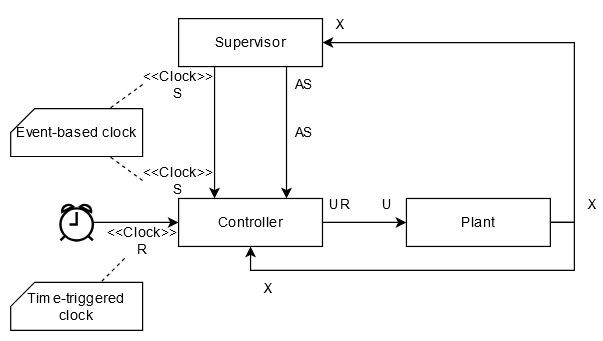
FMI Layered Standard for for Network Communication (FMI-LS-BUS)
The version v1.0.0 for CAN, CAN FD, CAN XL is in beta testing currently, and will be demonstrated at the International ASAM Conference in Munich in December. In parallel we made progress on the FlexRay support and are happy that we could tag v1.1.0-alpha.1. Thanks to all contributors and stay tuned.
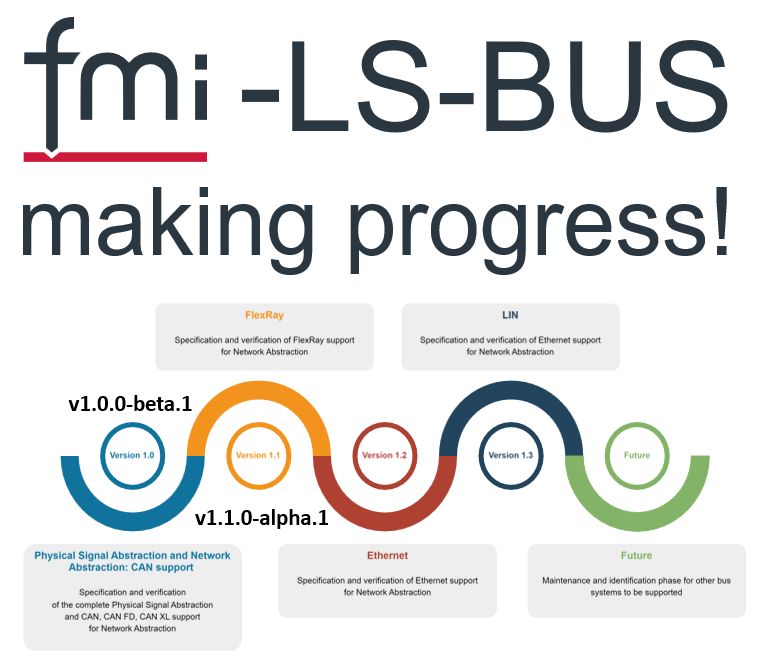
FMI Design Face2Face Meeting in Munich Dec 2-3 2024
AVL will host a face-2-face in Munich at the beginning of December. We will work on layered standards to the FMI standard and future improvements.
ASAM Conference in Munich Dec 4-5 2024
The FMI Project will present “FMI, Layered Standards and ASAM Standards - Enabling seamless SiL simulation of Virtual ECUs” at the coming International ASAM Conference in Munich. You can also meet us at the Modelica Association booth there.
We present three new Layered Standards for simulating virtual ECUs with FMI 3.0:
- FMI-LS-XCP for measurement & calibration with XCP
- FMI-LS-BUS for simulation of network communication with CAN (FD, XL), FlexRay, Ethernet, LIN
- FMI-LS-STRUCT for structured entities like lookup tables
A demo from tool vendors (Akkodis, Altair, AVL, Bosch, dSPACE, PMSF, SYNOPSYS) illustrates the interoperability of these layered standards.
Looking forward to meet you in Munich. More information on the conference on https://www.asam.net/conferences-events/detail/asam-international-conference-2024/.

16th Internation Modelica and FMI Conference!
We are are happy to invite you to the coming 16th International Modelica & FMI Conference in Lucerne, where the importance of FMI is now also reflected in the conference title.
Other Resources and Discussion Forums for FMI related Questions
- Join the LinkedIn FMI community to get the latest news on FMI, FMI supporting tools and discussions within the user community.
- Ask technical questions and discuss topics on the usage of FMI on Stackoverflow tagged “FMI”.
- Report problems of the standard itself or suggestions for new features in form of issues on fmi-standard.org.
This article is provided by MAP FMI
Related projects
FMI-based Digital Twins in European Projects on Railways
The project FP1-MOTIONAL, implemented by Europe’s Rail Joint Undertaking (EU Rail) and running from 2022-2026, addresses digitalization and data exploitation as a transversal topic essential for many innovation fields in railways such as automation, asset management, operational optimization and new sustainable rail system and service solutions.
The Work Stream 2 of the project aims at organizing in particular the modularity, interoperability and composability of the complex high-order digital twins. The figure below, provided by the partner CAF, exemplifies a system architecture currently under consideration to implement a digital twin for braking and traction.
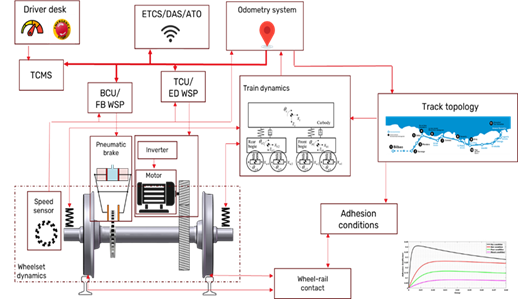
The Functional Mock-up Interface has been selected as the standard exchange format for model components to enable the reuse of existing models and tools and to allow IP-Protection of model content from commercial suppliers. Special attention in the use case driven work is given to a proper design of interfaces, i.e. the in- and output quantities of component FMUs. It is the goal to deliver a range of digital twin assembly templates similar to the Vehicle Interfaces Library in the automotive field. In order to prepare the future business case, the digital twins will be compliant and integrated into in the data ecosystem called Rail Data Space, also addressed within FP1-MOTIONAL.
The authors would like to acknowledge the funding from the Horizon Europe programme under grant agreement No. 101101973 — FP1 - MOTIONAL — HORIZON-ER-JU-2022-01.
Your feedback is very welcome!
This article is provided by Andreas Heckmann (DLR), Alex Meierhofer (VIF), Blas Blanco Mula (CAF)
Vendor news
orchideo | easySSP v1.3.8 now available
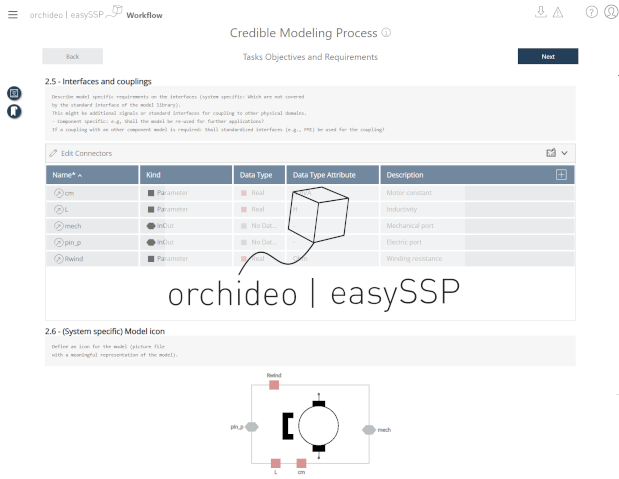
The latest easySSP update brings workflows, SSP 2.0 support and enhanced model parameterization:
The new Workflow functionality provides step-by-step interactive guidance directly within SSP containers. Workflow widgets support user inputs, metadata mapping, and seamless integration with SSP models and SSP Traceability data. Workflow documentation is automatically generated in Markdown, ensuring compatibility and easy sharing.
SSP 2.0 (BETA) support is now available, enabling more flexible model connectors, acausal connections and new FMI 3.0 compliant data types. While SSP 2.0 is still under development, easySSP already allows for importing, editing, and exporting models as SSP 2.0, paving the way for the upcoming standard.
The addition of Hierarchical Parameterization simplifies the management of model parameters. Parameters can now be defined globally or customized at component and system levels, providing flexibility while remaining fully SSP-compliant.
easySSP is completely based on open standards like SSP, FMI and SSP Traceability. Check out easy-ssp.com for more information!
This article is provided by Gregor Hermann, Peter Lobner eXXcellent solutions
Simple Integration of Artificial Intelligence in Modelica - SMArtInt+ Library
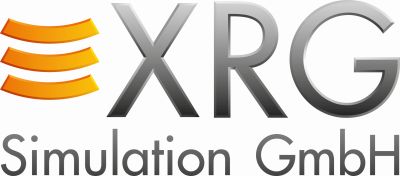
Our newest product SMArtInt+ enables hybrid physical and data-driven modelling in Modelica in a simple and convenient way. It has been developed and successfully validated in two recently finished research projects (PHyMoS and DIZPROVI). The Simple Modelica Artificial Intelligence Interface offers Modelica and Python tools that will help you to easily integrate neural networks of different sources and kinds in your Modelica models. It uses standardized interfaces, models and methods from the open source SMArtInt Library which is available from Github.

Use Case
There are endless applications to this noble-prize winning approach. For instance, modelling and validation heat transfer or pressure loss is a complex task in technical applications when accuracy needs to be high. In one of our research projects the aim was to replace a physical ClaRa model of a flue-gas heat exchanger with a hybrid version using measurement data from the original plant (kindly provided by LEAG). The hybrid model was clearly fitting the heat flow rate much more accurate as the figures reveal in comparison to the physical model.
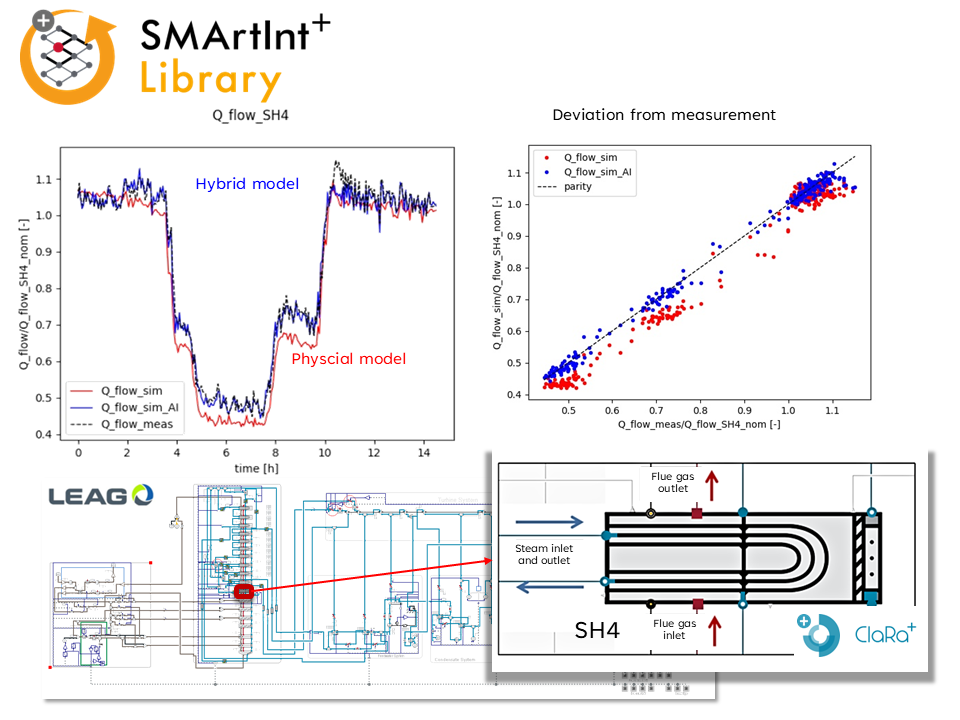
Profits of SMArtInt+
Machine Learning methods offer tremendous potential when data is available. Nevertheless, it still requires experienced users. Our SMArtInt+ tool-box provides you with the following user-friendly features and benefits:
- Support of TensorFLow, TensorFlowLite and ONNX formats
- Feed Forward Neural Networks, Recurrent Neural Networks (stateful or non-stateful), Neural ODE’s plain or for implementing more complex architectures like Generative Models (encoder / decoder) or BNODE
- Extrapolation and low training data density detection and notification to the user (warning and visualization in the Modelica model)
- De-dimensionalization of Neural Network inputs and outputs enabling more general applicability of trained models
- Automated Modelica model creation through Python and Modelica blocks
- Plattform-independent Modelica integration (Multi-Tool-Support, currently Dymola and OpenModelica have been tested)
We are happy to give more information on request.
References
- Open source SMArtInt version on Github
- J. Aka, J. Brunnemann, S. Freund and A. Speerforck:“Efficient Global Multi Parameter Calibration for Complex System Models Using Machine-Learning Surrogates”, Proceedings of the Int. Modelica Conference 2023, Aachen, Germany (Paper)
- A. Vojacek, J. Brunnemann, T. Hanke, T. Marx-Schubach and J. Eiden:“Status of the ClaRa Library: Detailed Transient Simulation of Complex Energy Systems”, Proceedings of the Int. Modelica Conference 2023, Aachen, Germany (Paper)
- J. Aka, J. Brunnemann, J. Eiden, A. Speerforck and L. Mikelsons:“Balanced Neural ODEs: nonlinear model order reduction and Koopman operator approximations”, preprint 2024 (Paper)
This article is provided by Stefan Wischhusen XRG Simulation GmbH
Simcenter Amesim 2410
Siemens Digital Industries Software is pleased to announce the recent release of Simcenter Amesim 2410 as part of its system simulation solutions. This release brings remarkable performance improvements to the solver and code generation that combine well with previous optimizations such as those related to so-called “0-flow” problems or to discontinuity handling in a co-simulation context. These improvements have a positive impact on the support of FMI and Modelica.

Accelerated simulations
While the original aim was to speed up the simulation of Pseudo-Two-Dimensional (P2D) battery models — achieved with a speedup factor of about 9 compared to release 2404 —, two generic solver enhancements have been implemented which have tangible positive consequences on all kinds of “large” models, including native models but also Modelica models and imported Model Exchange FMUs, as soon as the — default — variable step solver is selected. These enhancements, activated by default, are:
- A new heuristic for optimized calculations of Jacobian matrices,
- An optimized handling of sparse linear systems.
“Large” models represent a strong trend for system simulation across all industries, for example to serve electrification. They typically involve fine-grained spatial discretizations, numerous inputs/outputs, state variables, internal variables and/or parameters.
Improved code generation for Modelica and imported FMUs
Aside from accelerated simulations, the code generation performed when creating a Modelica model, importing an FMU, a pre-trained neural network (ONNX file) or a response surface, has been upgraded to “V2”, featuring lightweight and more CPU-efficient code. For Modelica and FMI, the outcome is a more robust coupled simulation with “large” models. For highly-hierachical Modelica models, this results in compilation and simulation times that compete with 100% Modelica-based tools, for example with models coming from Lawrence Berkeley’s open-source Buildings Library v11.0.0.
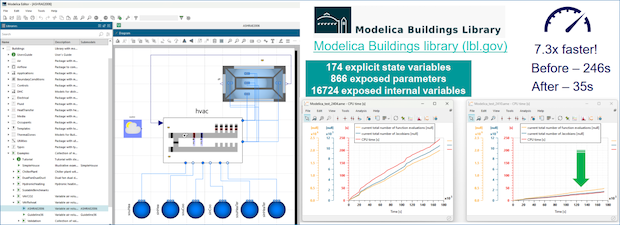
Fast-running exported co-simulation FMUs
Obviously, the above-mentioned solver improvements for native or hybridized models are automatically reflected — embedded — in exported FMUs for co-simulation, for the deployment of performant plant models. Combined with the optimized discontinuity handling introduced in release 2304, the speedup is further maximized in this context since at each co-simulation rendez-vous point, the solver’s current pace is kept unchanged whenever possible. This strategy is in place independently of the chosen import tool. A typical use case is when the Simcenter Amesim FMU is connected to a controller model whose outputs may have changed little or not at all during a co-simulation time step.
For more information on Simcenter Amesim, please visit our website.
This article is provided by Bruno Loyer (Siemens Digital Industries Software)
OpenModelica 1.24.0
Version 1.24.0 of OpenModelica was released on 9th October 2024. It has many improvements and bug fixes. Graphical Editor (OMEdit) was updated to support both Qt5 and Qt6.
OpenModelica Compiler (OMC)
The new front end has been further improved with about 25 issues solved, here is a complete list. Nine of those issues regarded fixes to the new experimental Base Modelica flat output.
A new compiler flag –exposeLocalIOs was added to automatically add the outputs of a model components to the outputs of an FMU, instead of only adding the top-level outputs. This can easily provide monitoring information in an FMU without the need of painstakingly bring all those outputs to the top level in the original Modelica model.
Besides #12730, the work on the backend was mostly focused on developing the new backend, with 14 issues being fixed.
One small fix was made to the C runtime.
Graphical Editor (OMEdit)
The OMEdit source code was adapted to use both Qt5 and Qt6, see pull request #12485.
The quality of the OMEdit GUI was further improved over the previous version 1.23.1, with about 15 issues fixed, see the complete list.
An important improvement regarding the usability of the GUI concerns the reaction time when editing diagrams, which used to be very slow when adding or removing components and connections in large models; these operations are now much faster, while changing parameters can still be quite slow. See #11920 for more details.
The full 1.24.0 release notes are available here.
The next release 1.25.0 is planned to be released in January/February 2025, with a first beta release possibly before the end of the year. It should include further improvements to the GUI such as parameter editing in hierarchically structured model, restructured Simulation Setup dialog, rename feature with refactoring, faster editing of large models, etc. Further improvements in FMI 2.0.x export are also planned.
This article is provided by Adeel Asghar, Francesco Casella Open Source Modelica Consortium
Modelon News

New and Updated Features in Modelon Impact
We’ve been hard at work making significant enhancements to Modelon Impact. Here are a few of the product highlights from the recent 2024.2 release.
Analysis View
We now have a dedicated space for data visualization in Modelon Impact. While users can still configure graphs in the model view, they can now configure multiple plots and graphs simultaneously for comparative analysis.
Analysis View includes a histogram chart, stacked chart options, and the existing line graph and scatter plot options. All four chart options support dynamic and steady-state simulations.
Users can also view the results for a single simulation or a customizable set of multiple simulations. This helps users zero in on the desired results, even when performing batch simulations.
Experiment Setup
Multi-run simulations in Modelon Impact just got more powerful. Users can now easily set up multiple simulations with parameter sweeps, making comparing configurations such as controller types and initialization options easier.
Users can also execute a Design of Experiments by specifying the number of cases they want to run and the distribution parameters.
Native Calibration Workflow
We’ve now built an out-of-the-box custom workflow for calibrating a model against a dataset. This calibration workflow package includes calibration examples and a customizable web application for data visualization.
We’ve also made significant additions to our libraries regarding Hydrogen-Powered Aircraft Applications, Improved Thermal Management Modeling, and Energy Systems Optimization.
More about the latest Modelon Library updates.
Read the full release notes here.
New Case Study
MAN Energy Solutions: Creating a Virtual Test Bed for Next-Gen Industrial Heat Pumps
MAN ES has been researching and developing large-scale industrial heat pumps, which are vital for creating sustainable heating solutions for industries and municipalities.
Dynamic models for transient simulation are integral to their design, validation, and commissioning process. When searching for a platform and partner to dynamically simulate their CO2 heat pump, they chose Modelon.
Event Recap
Modelon Innovate 2024
Modelon Innovate 2024 took place on October 10-11th in Copenhagen. The two-day event brought together over one hundred system modeling and simulation experts from fifteen countries. The event featured insightful presentations on system simulation and hands-on workshops to enhance attendees’ skills in developing innovative physical systems in commercial industries.
Watch the conference highlights.
Sign up for the Modelon newsletter.
This article is provided by Matt Bourland (Modelon)
Model Based Innovation LLC Opens for Business

As a long time member of the Modelica community It is my pleasure to announce my newly openend company: Model Based Innovation LLC, based in West Hartford, Connecticut.
As a founding member of the member of the Modelica Asssociation, and co-founder of Modelon, I have now started a new venture that will again be fully focused on the open standards of the Modelica Association, and combine that in-depth knowledge with process consulting to help companies speed up their journey towards efficient model based design, and model based systems engineering.
With my unique experience of being from Europe, but US-based, my goal is to introduce the European-based standards and solutions Modelica, FMI, eFMI and SSP to the US market. I will do this as an independent consultant, and also as a partner of the companies from the European Ecosystem of Modelica Association solutions, helping to find the best fit .
Interested? Please contact me by subscribing to my newsletter via the sign-up form at https://modelbased.cloud/. You can also contact me directly via firstname.lastname[at]modelbased.cloud, I’m looking forward to discussing your needs with you!
Hubertus Tummescheit, Founder and President, Model Based Innovation LLC
This article is provided by Hubertus Tummescheit, Model Based Innovation
Dymola 2025x
Dymola 2025x will be released on November 29, 2024.
Parameter arrays
Variable-length parameter arrays makes it possible to represent lookup tables in native Modleica, without the use of C code and external objects. Parameter arrays can be initialize at simulation initialization, not translation. Dymola allows such arrays to fix the size hen data is read. This is also supported in FMUs generated by Dymola.
Parameter records
Parameter records in Modelica can be created by reading a data file in SSV or CSV format. It is also possible to let Dymola modify an existing parameter record. Data from the file include the name of the variable, default value, unit and description.

Simulation speed
Code generation for Modelica functions has been significantly improved, especially for array handing and with optimizations for constants and parameters. Typically, this has good effect in fluid systems with many function calls for media calculations. For example, the VaporCycle model from the ThermofluidStreams library runs more than 2x faster.
FMI co-simulation technology
We have implemented new co-simulation technology aimed to improve performance of “heavy” FMUs with variable-step solvers. For the right model it reduces the number of f-evaluations and Jacobian evaluations. The fundamental idea is to smooth continuous-time Real inputs by linear interpolation during the next doStep() call. This means the numeric integrator can continue without costly resets, leading to larger step-size and fewer evaluations. Furthermore, a predictor compensation gives better error estimates.
TIL-Suite libraries
The existing ThermalSystems library is replaced by TIL-Suite from TLK-Thermo. This change will offer more complete range of libraries and extended functionality.
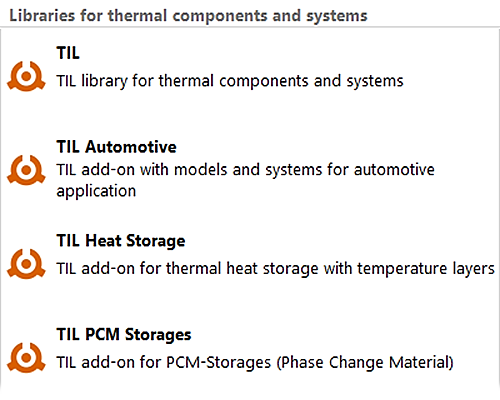
It is divided into four library products at Dassault Systèmes:
- TIL Base Library
- TIL Mobile Air Conditioning Library
- TIL Hydrogen Library
- TIL Thermal Storages Library
There is a free upgrade for existing customers of ThermalSystems to TIL Mobile Air Conditioning Library.
Dymola Modelica Compiler
For toolchain integrators we now present the most minimalistic version of Dymola ever, the Dymola Modelica Compiler (DMC). It is a command-line tool that can translate models, export FMUs, simulate and run mos-scripts. DMC requires the usual Dymola license.
This article is provided by Dag Brück (Dassault Systèmes)
News from libraries
TLK TIL Suite - New version 2024.1

TIL Suite is suitable for the stationary and transient simulation of all types of thermodynamic systems. Thanks to the fast calculation of thermophysical properties (TILMedia) and many other numerical optimizations, complex thermal systems such as reversible heat pump systems can be dynamically simulated.
In October the TIL Suite 2024.1 was released and among others, the following new features are included:
- Time-variable specification, control or optimization of geometry variables, such as a heat exchanger length or diameter, in the TIL base library and Add-On Hydrogen Energy Systems
- Extended and improved geometry calculation for plate heat exchangers, e.g. for the specification of an asymmetrical number of channels
- Multi-port version of the thermal models for ‘heat’-resistances and -capacitances for simple graphical modeling and parameterization, e.g. for discretized applications
- New calculation model according to ‘Mc Adams’ in VLEFluids from TILMedia for dynamic viscosity in the two-phase region
The version prior to TIL Suite 2024.1 is 3.16.0. The versioning has been changed to only two numbers with the release year included. It is now standardized in all products of TLK-Thermo. As with the previous versions, it is possible to update your customer models automatically using the included conversion scripts.
For further information about TIL Suite see www.tlk-thermo.com or contact us at til@tlk-thermo.com.
This article is provided by Ingo Frohböse TLK-Thermo GmbH
Testing Library 1.8.0: Reimplemented functions tests
Since the first release the Testing library supports unittests for Modelica functions.
However, this was always one of the weaker parts, as it required manual comparison of expected and actual values and setting the final test result.
Since Testing library 1.8.0 (shipped in spring with Dymola 2024x Refresh 1), test functions are much simpler to create, thanks to the new operator record Testing.Functions.Check.
The code snipped below shows how the algorithm section of a modern test function for the Modelica.Math.isEqual could look like:
checks[1] := Check(
expect = true,
actual = isEqual(0.333, 1/3, eps=1e-3));
checks[2] := Check(
expect = false,
actual = isEqual(0.333, 1/3, eps=1e-4));
// if we expect true, we can also use the short version
checks[3] := Check(isEqual(-0.333, -1/3, eps=1e-3));
result := Check.summarize(checks);
You just have to pass the expected and the actual values to Check.
The Check.summarize functions computes the overall test result from our vector of checks and prints details when a check has failed.
Check has constructors for String, Integer, Boolean and Real inputs, from scalar to 3D.
Comparing vectors of strings for example works similar as above:
checks[1] := Check(
expect = {"angle", "force", "pressure"},
actual = .Modelica.Utilities.Strings.sort({"force", "angle", "pressure"}));
More information about function tests can be found in the Testing library at Testing.Functions.UsersGuide..
This article is provided by Marco Keßler (Dassault Systèmes Austria GmbH)
Education news
Claytex technical blog

Claytex publishes a technical blog covering all things Modelica and Dymola.
Experiments with causality (Project Hail Mary physics)
Modelica does not require causality to be assigned in equations. This means that a Modelica solver, such as Dymola, must be able to solve an equation regardless of which variables are inputs and which are unknowns. To test this in Dymola an example based on flying a spaceship, as is done in the book ‘Project Hail Mary’, has been created.

Read the complete article here
Golf ball rolling out of hole (Part 1)
This blog article creates a simple model to explore the behaviour of a golf ball rolling out of a hole after it’s rolled into the hole.

Read the complete article here
Modelling Air-Oil Mixtures in Hydraulic Systems: Understanding Bulk Modulus and the Claytex Fluid Power Approach
In any dynamic fluid system, modelling the medium is a crucial step for achieving accurate and realistic simulations. For hydraulic system modelling, the fluid’s bulk modulus which represents the resistance of the fluid to compression, significantly affects the system’s behaviour and stiffness. Since fluid in a hydraulic system is most times under extreme pressure for system operation, it is essential to determine the correct bulk modulus and understand the factors influencing its behaviour. Temperature, pressure, and the presence of air are the main factors affecting the bulk modulus. However, in this blog post, we focus on the presence of air in oils, which significantly reduces the fluid’s bulk modulus, and discuss the modelling approach used in the Claytex FluidPower library.

Read the complete article here
This article is provided by Mahdieh Mehrabi (Claytex)